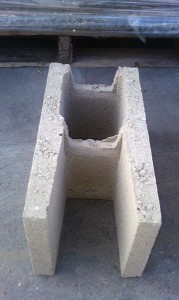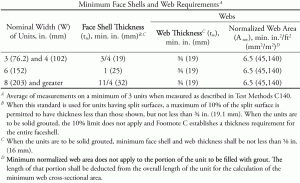Question
Recent changes were made to ASTM C90 related to the minimum web requirements for loadbearing concrete masonry units (CMU). What, if any, impact do these changes have on the design of concrete masonry assemblies?
Answer
For the vast majority of loadbearing concrete masonry construction, there is little difference in the resulting design methodologies or assumptions when using CMU meeting the new ASTM C90, Standard Specification for Loadbearing Concrete Masonry Units. However, there are some nuances that structural engineers should be cognizant of if opting to specify alternative unit configurations now permitted under the new ASTM C90 standard.
The Table summarizes the new minimum unit configuration requirements contained in ASTM C90. Compared to historical versions of this standard, the minimum web thickness for all unit sizes is now 0.75 inches where previously it varied from 0.75 inches to 1.125 inches, depending upon the nominal thickness of the unit. Additionally, the equivalent web thickness (which is the summation of the thickness of each web in a unit normalized per unit length) has been replaced with a normalized web area, which cannot be less than 6.5 in.2/ft2 for all units. The drawback of the historical equivalent web thickness requirement was that it did not capture possible variations in the height of the web, which is commonly reduced or notched for various reasons. The normalized web area sets a minimum value for the web to connect the face shells of a unit.
It is important to stress that the revisions to ASTM C90 do not require unit configurations to be changed; instead, they permit more flexibility in unit configuration to meet evolving market-driven demands. Any unit configuration that met historical ASTM C90 requirements will continue to comply with contemporary versions of this standard.
Of primary importance to structural engineers, new unit configurations used in reinforced and grouted construction will still be structurally modeled and designed as they have been in the past, taking into account the appropriate section properties to reflect the cells containing grout and reinforcement. However, for unreinforced/ungrouted masonry, the thinner webs permitted under the latest ASTM C90 standard can impact the resulting section properties of the assembly, and therefore the resulting assembly design strength. Since unreinforced, loadbearing masonry construction is rarely used any longer in the United States, these change will have little effect structurally. However, for those engineers still designing with unreinforced masonry, such structural impacts should be considered.
So why change the iconic configuration of the concrete masonry unit? The short answer is that this change has already occurred in the marketplace, resulting in unit configurations such as H-Block, bond beam units, lintel units, and multi-purpose units that have evolved to meet specific project needs. Depending upon one’s perspective, these changes to ASTM C90 offer several potential benefits, including reducing unit weight (reducing structural dead load and increased construction productivity) as well as substantially increasing the thermal R-value of concrete masonry construction.


